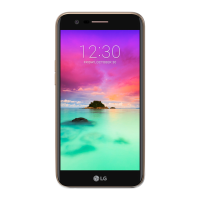
Do you have a question about the LG K10 2017 and is the answer not in the manual?
| Display Size | 5.3 inches |
|---|---|
| Resolution | 720 x 1280 pixels |
| Display Type | IPS LCD |
| Processor | Mediatek MT6750 |
| GPU | Mali-T860MP2 |
| RAM | 2 GB |
| Rear Camera | 13 MP |
| Front Camera | 5 MP |
| Battery | 2800 mAh |
| Operating System | Android 7.0 (Nougat) |
| Dimensions | 148.7 x 75.3 x 7.9 mm |
| Weight | 142 g |
| SIM | Single SIM (Nano-SIM) or Dual SIM (Nano-SIM, dual stand-by) |
| Network | GSM / HSPA / LTE |
| Bluetooth | 4.2, A2DP, LE |
| USB | microUSB 2.0 |
| Sensors | Fingerprint (rear-mounted), accelerometer, proximity, compass |
| Internal Storage | 16GB |
| Colors | Black, Gold |
Use the wide-angle on the front camera for a wider field of vision.
Use two apps simultaneously by separating the screen into multiple windows.
Share a photo or video to another app immediately after taking it.
Details of items included with the device and recommended accessories.
Diagrams illustrating the physical components and ports of the device.
Instructions on how to power the device on, off, or restart it.
Step-by-step guide for inserting the SIM card and battery.
Instructions on how to insert a microSD card into the device.
Steps to safely unmount and remove the memory card.
Guidance on how to charge the device's battery.
Explanation of various touch screen gestures and their functions.
Overview and layout of the device's Home screen.
How to set up and configure screen lock for security.
Turning the screen on or off by double-tapping the screen.
Unlocking the screen by creating and using a Knock Code pattern.
How to encrypt and protect data saved on the memory card.
Methods for capturing screenshots of the device screen.
Using the Smart keyboard and moving the cursor.
How to limit or mute notifications to avoid disturbances.
Steps for installing and removing applications from the device.
Making, answering, and managing phone calls.
Taking photos and recording videos with the device's camera.
Viewing and managing photos and videos saved on the device.
Playing and managing music files and albums.
Registering, checking, and sending emails.
Managing events and tasks using the calendar.
Creating and managing notes with advanced features.
Using the simple and scientific calculator functions.
Setting alarms, world clocks, and timers.
Using the stopwatch to record lap times.
Viewing, deleting, or sharing downloaded files.
Viewing and managing files stored on the device or cloud.
Listening to FM radio stations.
Recording and saving voice memos.
Adding, importing, and searching for contacts.
Editing, deleting, and creating contact groups.
Downloading games, apps, and content from LG.
Registering and managing tasks for schedules.
Backing up, restoring, and moving device data.
Remote diagnosis and support for device issues.
Writing and collecting information, sharing with other devices.
Using the social networking service to update and share posts.
Capturing and sharing photos/videos with filter effects.
Signing into Chrome and importing browser data.
Using Google apps by setting up a Google account.
Registering a Google email account to check or send email.
Searching for web pages, images, and news.
Finding locations and viewing geographical information.
Viewing or sharing photos or albums saved on the device.
Renting or purchasing movies using a Google account.
Purchasing and playing music files from the Play Store.
Creating or editing spreadsheets online or from another device.
Creating or editing presentation material.
Searching and playing videos, uploading to share.
Customising device settings according to user preferences.
Connecting to Wi-Fi, Wi-Fi Direct, Bluetooth, and mobile data.
Pairing devices and sending data via Bluetooth.
Turning mobile data on/off and managing usage.
Customising call settings, including voice and international calls.
Using NFC and Android Beam for data sharing.
Connecting to a Bluetooth printer and printing photos/documents.
Sharing mobile data via USB or Wi-Fi hotspot.
Connecting a Bluetooth device to the Internet via mobile data.
Viewing help on tethering and hotspots.
Accessing additional settings like Airplane mode.
Customising mobile data settings and network types.
Connecting to a safe virtual network.
Customising sound, vibration, and notification settings.
Customising screen settings like theme, font, and brightness.
Customising language, keyboard, location, and accounts.
Adding and managing accounts, and syncing data.
Managing accessibility features for vision, hearing, and motor control.
Using volume keys to launch apps when the screen is off.
Managing Google apps and account settings.
Setting up content lock, encryption, and SIM card lock.
Customising date and time settings for the device.
Viewing and managing internal and portable storage.
Viewing battery usage and enabling power-saving mode.
Viewing memory usage and occupied memory by apps.
Viewing installed apps, stopping, or deleting them.
Making payments using the device instead of a credit card.
Backing up data, resetting device, and managing settings.
Viewing device information, status, and legal details.
Viewing regulatory marks and safety information.
Selecting a language to use on your device.
Managing device files and software via computer.
Steps to install the LG Bridge software on a computer.
Updating device firmware from the Internet.
Updating phone software wirelessly without a USB cable.
Answers to frequently asked questions and troubleshooting tips.
Protecting the device from unauthorized use after reset.
Open source software notices, regulatory information, and trademarks.
Statement of compliance with essential requirements and provisions.
Technical specifications for frequency bands and output power.
Guidelines for disposing of waste electrical and electronic products.
Guidelines for disposing of used batteries and accumulators.